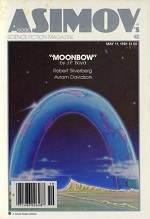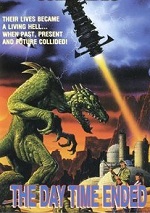|  
 
 
 
 
 | | | |  | | The Cases of Ben Hardy, Time Detective
by Warren Salomon
First story: Asimov’s Science Fiction, 11 May 1981

For me, Salomon’s first story of Ben Hardy, hard-boiled temporal private eye, was about one Delorean shy of having enough boisterous fun that I could completely ignore the inconsistencies in the time-travel model—but even so, I had fun as Ben attempted to restore time to its rightful path for heiress Patricia Wadsworth (and in the process try to figure out the familial relations between himself, Pat, Pat’s parents, the inventor of time travel, and that dastardly lawyer).- Time & Punishment (11 May 1981) first story in Asimov
- Time on My Hands (Oct 1982) in Asimov’s
- As Time Goes By (Feb 1984) in Asimov’s
 They all say that. “Why is it,” I asked her, “you seem to remember the, ah, original sequence? In a reality change, memories are altered along with everything else. How can you be certain that time has been tampered with?” That question usually ends it right there. They all say that. “Why is it,” I asked her, “you seem to remember the, ah, original sequence? In a reality change, memories are altered along with everything else. How can you be certain that time has been tampered with?” That question usually ends it right there. 
| |
| | | | |

 
 | | | | 

| | The Day Time Ended
aka Time Warp, aka Vortex, aka Earth’s Final Fury, aka Black Thunder
by Wayne Schmidt, J. Larry Carroll, David Schmoeller, et.al. (Bud Cardos, director)
First release: 31 Jul 1981

After an hour or so of mundane conversation, a triple supernova, a UFO, a tiny mannikin/alien, and creepy lights, the Williams family and their horses are transported through a time-space warp to an unknown time for the other twenty minutes of the movie. (The creepy lights stick around, too.) It’s hard to tell for sure, but I think they’re going to live out their lives amongst the weird lights and crystal structures of this new time. Sadly, I never did see the giant lizard. Steve, you know what this is, don’tcha? It’s a time-space warp. Steve, you know what this is, don’tcha? It’s a time-space warp. 
| |
| | | | |

 
 
 
 
 
 
No Time Travel. Move along. |
“These Stones Will Remember” by Reginald Bretnor, Asimov’s, 16 Feb 1981 [viewing the past ]

“The Jaunt” by Stephen King, Rod Serling’s The Twilight Zone, Jun 1981 [differing time rates ]

“The Gernsback Continuum” by William Gibson, Universe 11, Jun 1981 [alternate timelines ]

“Liros: A Tale of the Quintana Roo” by James Tiptree, Jr., Asimov’s, 28 Sep 1981 [no definite time travel ]
aka “What Came Ashore at Lirios”

“The Pusher” by John Varley, F&SF, Oct 1981 [time dilation ]

| |     |